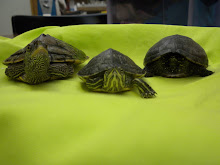


One of the most common questions you will hear from young children when you are reading something particularly interesting to them is, "Is it real?" Nonfiction is huge with the lower elementary set, especially (and please don't bash us for being sexist, because it's true) boys. Trucks, space, dinosaurs, and animals, animals, animals!
Unfortunately, there has been a trend for a long time to skip the science in younger grades - reading and math are SO much more important, we have too many phonics and flashcard drills to do to mess around with science and social studies, except for maybe half an hour on Fridays. By fifth grade, when standardized tests start counting those subjects and we start trying to make up for lost time, many of the kids have lost interest.
Fortunately (hmm, this is starting to read like a popular old story), publishers have started listening to the poor beleaguered teachers waving their hands and saying, "Can't we COMBINE reading and science? I mean, isn't that how we know kids learn best?"
Enter the nonfiction books we refer to at our library as "Junior Readers". These aren't new by any means, but the quality has improved SO much in the past 5 or 10 years - both in substance and in appeal. This is one such series. The pictures are clear and beautiful (we want a porcupine!), the text is just right for, say, a first grader, without sounding too choppy or dull. "Fun Facts" at the end provide just a little more trivia, and a short glossary and index offer an introduction to the parts of a nonfiction book.
Know what animal we would like to see in books of this type, though? People. Not just because many small children don't realize that people are mostly animals (we have known a few that more resembled vegetables), but because children who have grown up exclusively in one type of habitat sometimes don't realize people live amongst the scorpions and roadrunners, or the bighorn sheep. That's just personal commentary, not a negative reflection on this series.
We live in a somewhat unique area that includes all three of the above habitats - in a forest on a mountain range that surrounds a desert. In any given day Miss Ami may see a mountain lion, a skunk, and a deer on the way to work, where she may have to shoo a gecko away from the door. Our young patrons are sure to enjoy this series, and we will be ordering the rest of the titles (covering grasslands, lakes, and the ocean) shortly. We give them a
5 out of 5.
Don't forget to check out the other nonfiction Monday posts.


No comments:
Post a Comment